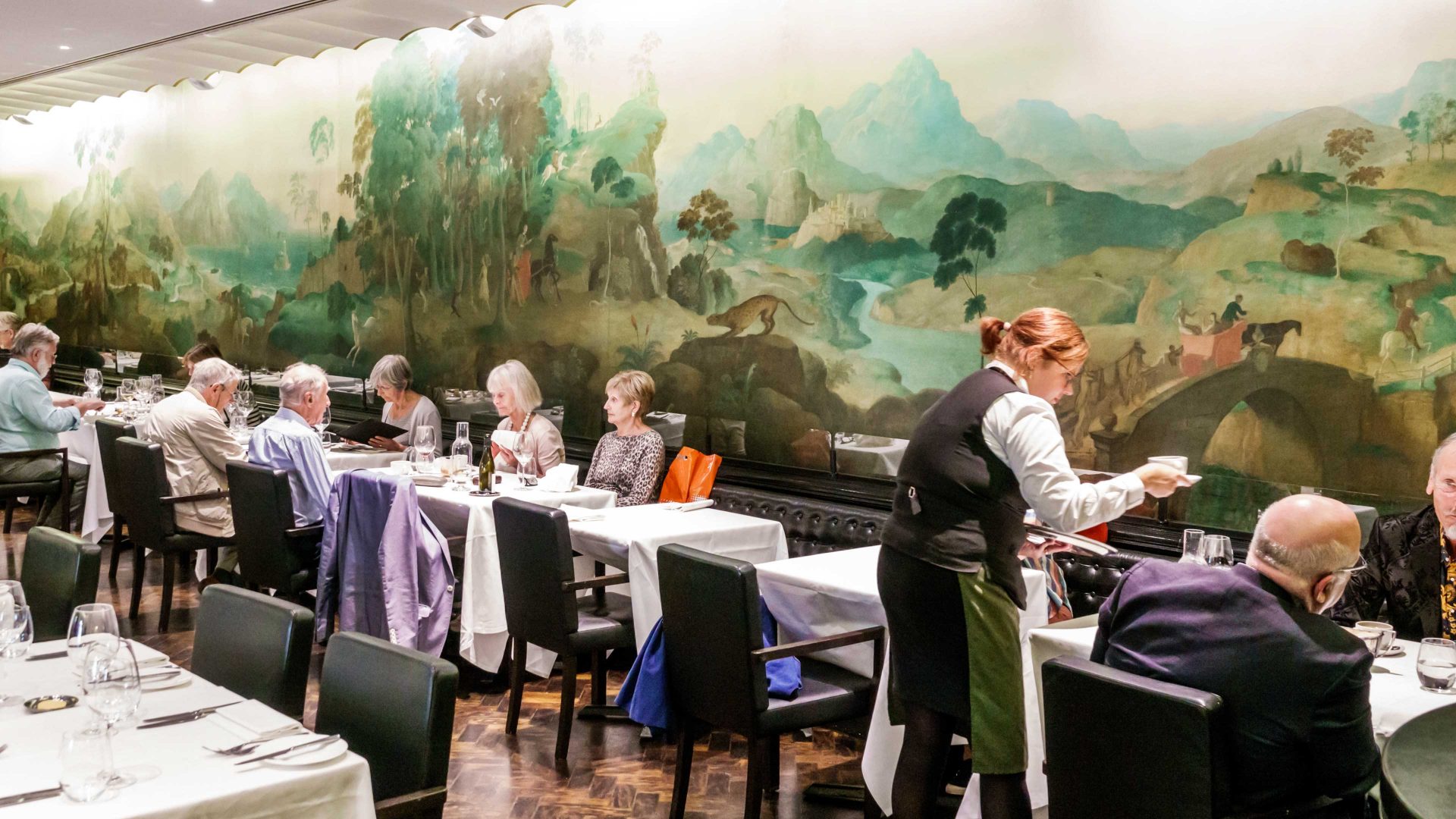The former Rex Whistler restaurant at Tate Britain reopened in March, so gallery-goers could view its notorious murals; together with a site-specific film, Viva Voce, made by Keith Piper, to give the context for these artworks, and interpret them for a contemporary audience. It’s taken MM this long to venture in – but then, as regular readers probably know by now, I have a pretty violent antipathy to art galleries.
Most will also be familiar with the backstory: the murals were commissioned from the artist in 1924 by the Tate’s then-director. Whistler, although from a fairly pedestrian middle-class background (he grew up in Eltham in south London), nevertheless evolved (or possibly de-evolved) into one of the Bright Young Things, and was pals with the notoriously dandiacal Stephen Tennant, who’s depicted in the mural, as is Whistler’s teacher at the Slade, Henry Tonks, and various other luminaries.
Entitled The Expedition in Pursuit of Rare Meats, and executed in a whimsical and etiolated style, a little bit reminiscent of a yet-feyer Cocteau, I can’t say the murals ever struck me as that interesting, let alone deserving of Tonks’s hyperbole “the most amusing room in Europe”, which for many years the Tate deployed to drum up custom.
I must have eaten there a few times over the years, but hardly glanced at Whistler’s wall-daubs – and that is, I think, the fate of murals, which, so long as their abstractions or figurations have a certain regularity, tend to regress to the condition of… wallpaper. Anyway, I certainly never noticed the black woman and child, the latter roped and being led along by one of the white meat-pursuers, the former taking refuge in a tree. Elsewhere in the mural there are stereotypically depicted Chinese figures as well – if, by “stereotypic” is meant western visualisations that reduce them to a few obvious characteristics.
It might be adjudged more upsetting than the indisputable racism of these images, that it took until 2010 for serious concerns to be raised about the work – and in part, these only really came about because of the necessity for the mural’s restoration. As the art agitators White Pube, who started the online petition against the mural pointed out, this jibes with the undeniable fact that the demographic of the restaurant’s clientele – and indeed of the gallery overall – is overwhelmingly old and white.
There were a few of us pallid and ambulatory colostomy bags plumped down on banquettes in front of the two giant VDUs on which Viva Voce is shown. The rest of the room is, of necessity, darkened – otherwise you wouldn’t be able to see an actor playing the part of a sort of ahistorical arbiter; and named Professor Shepherd – as if to elide godliness and antiracism – hectoring an actor playing Rex Whistler.
As the professor berated him for not having realised the import of the narrative he had depicted, and for succumbing to lazy stereotypes in his depictions – even though he must have seen real black people in his time – I couldn’t help but feel that Viva Voce was effectively recapitulating the history of the murals’ own reception.
For Rex Whistler, read all those “racists” – myself included – who sat there stuffing our faces, surrounded by images of rich whites hunting benighted blacks, and treating with wily Orientals. Except that the analogy holds good all the way to the bottom of this big bowl of wrong: just as we were unconscious of the presence of these negative images, so I very much doubt that Rex Whistler ever gave much thought at all to any of the following: the relative status of black and white people; the historical injustices inflicted on the former by the latter; or indeed, what he might do to rectify this state of affairs.
If we want to call this “unconscious racism”, then that’s fine by me – I suspect a better way of viewing it is that this is the way the world was. Now it’s changing – and that’s a good thing, but personally, I’d like to see a revolution with a little more clarity, and a lot less contemporary self-righteousness – which is wholly unwarranted. Rex Whistler is entirely dead – while those of us watching Viva Voce have little influence or significance beyond the fact of the fundamentally economic injustice we epitomise.
And its intersection with the racial divide in this country. So, come on Tate Gallery, if you really feel the need to right a historic injustice, do it by ameliorating a contemporary one. How about an extraordinary “Most Amusing” levy on Tate members, the proceeds to go to funding art education for disadvantaged young people, whatever those disadvantages consist in?
I can’t think of a better way for this institution – itself the result of a beneficence afforded, if only at a remove, by the expedition for exotic sweets – to celebrate the election of what many of us hope will be a profoundly redistributive government.



